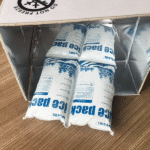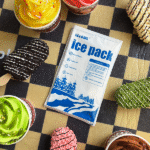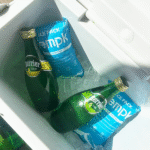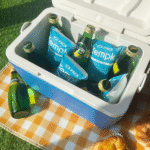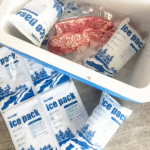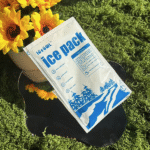If you need the best dry ice bag for vaccines, escolha um ventilado, forro de grau médico que libera CO₂, evita o contato do frasco, and fits an IATA PI 954–ready shipper. You get stable ultra-low temperatures (em torno de -78,5 °C), conformidade regulatória, and fewer rejected shipments. This guide combines field-tested methods, current checklists, and practical tips you can apply today.
-
When to use a dry-ice solution for ultracold vaccine shipping
-
How to choose the right liner and size the charge
-
Step-by-step packing that stays PI 954 compatível
-
What to avoid and why, mais 2025 trends that matter
When do you actually need the best dry ice bag for vaccines?
Resposta curta: Use the best dry ice bag for vaccines only for products labeled for ultracold (≤ −60°C) or deep-frozen (−50 °C to −15 °C) lanes where dry ice is required. Refrigerated vaccines (2–8 ° C.) should not use dry ice because over-cooling can damage potency. Always verify the product label and route qualification notes.
Por que isso é importante para você: Vaccines are sensitive; even small swings can reduce efficacy. Dry ice sublimes to CO₂ at −78.5 °C, então os pacotes devem ventilar. For mRNA or other ultracold products, a vented liner inside a validated shipper preserves temperature while avoiding pressure build-up. For 2–8 °C or standard-frozen products, choose PCM/gel packs instead.
Sizing the best dry ice bag for vaccines for 24–72-hour lanes
Aim to right-size the charge to the lane and shipper performance. Como início de planejamento: ~2–6 kg per 24 h for mid-size foam/VIP shippers, scaling with ambient extremes. Leave headspace in the vented bag so CO₂ escapes. If you consistently exceed ~9–10 kg per 48 h, step up to a larger, better-insulated shipper rather than choking vent paths.
| Choice you’re making | Good baseline | When to upsize | O que isso significa para você |
|---|---|---|---|
| Bag material | Vented PE/HDPE (2–4 milhões) | Multilayer/foil-laminate for >48 h | Sublimação mais lenta, maior tempo de espera |
| Charge per 24 h | 2–6 kg typical | >6 kg in hot lanes | Validar com registradores de dados |
| Tipo de forro | Micro-perfs | Valve liner for dense loads | More controlled venting, fewer bulges |
Dicas práticas que economizam tempo e produto
-
Separate vials from ice: Add a rigid spacer or tray; nunca permita contato direto.
-
Keep vents open: Don’t over-tape inner lids; CO₂ deve escapar.
-
Label precisely: Marque “dióxido de carbono, sólido / UN1845” and net dry ice mass in kg on one vertical side.
Caso do mundo real: A cross-border mRNA route switched from plain LDPE to vented foil-laminated bags and extended hold time by ~27% while cutting dry-ice consumption ~15%.
How do you pack with the best dry ice bag for vaccines passo a passo?
Etapas principais: Condition components, load product centrally, insira um espaçador, fill the best dry ice bag for vaccines above or around the payload, close without sealing vents, then label and log. Mantenha o EPI ligado, work in ventilation, and place a calibrated data logger with the vials.
Orientação expandida:
Use a ventilated outer carton with a rigid inner (EPS, PPE, ou VIP). The best dry ice bag for vaccines must not be airtight; leave headspace for CO₂. For UN3373 specimens, garantir 95 kPa secondary containment (different from the dry-ice liner). Mark UN1845 e NET KG. Many carriers mirror IATA PI 954 em 2025, so aligning once reduces delays across lanes.
Valve liner vs. micro-perforated liner—what should you pick?
For most parcel shippers, um micro-perforated vented liner is fast and economical. If the load is dense, voids are minimal, or routes are long, um one-way valve liner offers more predictable gas regulation and reduces “ballooning.” Both options qualify when vents stay clear and the shipper is PI 954–ready.
Dicas acionáveis
-
Use divisórias: Keep fragile vials away from pellets to avoid thermal shock.
-
Weigh your charge: Record net kg dry ice accurately—2025 checklists are stricter.
-
Plan replenishment: Para pistas longas, choose a bag that opens/re-closes without blocking vents.
Caso real: A biotech moved to multilayer vented liners (4 kg per shipper) and held −75 °C for 48 h consistently; inspections sped up because UN1845/net-kg prompts were printed on the liner.
When should you avoid a dry-ice approach for vaccines?
If the label says 2–8 ° C., fazer não Use gelo seco. Escolher Pacotes de PCM/gel and validated refrigerated pack-outs. For standard frozen vaccines, use frozen packs and a barrier, não gelo seco. Dry ice remains the right tool only when the product requires ultracold ranges—and only with a vented system.
2025 trends that shape the best dry ice bag for vaccines
Visão geral da tendência: 2025 acceptance checklists reinforce PI 954 rotulagem, preciso kg-líquido marcação, and visible vent paths. Reusable EPP/VIP systems, IoT temperature + Sensores co₂, e aerogel/VIP hybrids extend hold time so you can reduce charge mass. Programs increasingly reserve dry ice for ULT lanes while using PCMs for 2–8 °C to cut risk and waste.
Último progresso em um olhar
-
Valve liners mature: Better gas control for dense pack-outs and long routes.
-
Audit-ready packaging: Printed prompts and QR job aids reduce errors at tender.
-
Sustainability uptick: Returnable shippers and lower dry-ice loads meet ESG goals.
Insight de mercado: Demand for temperature-sensitive biologics keeps rising. Teams that combine vented liners, precise labeling, and live telemetry see fewer rejections and less product loss. Closed-loop, reusable systems help control cost while meeting GDP documentation expectations.
FAQ — best dry ice bag for vaccines e conformidade
Q1: What is the best dry ice bag for vaccines right now?
A vented PE/HDPE liner or a one-way valve liner sized to your qualified charge, used with a spacer so vials never touch the ice.
Q2: How big should the best dry ice bag for vaccines be?
Match it to the shipper and route: a common start is ~2–6 kg per 24 h for mid-size cartons; validate with data loggers and seasonal trials.
Q3: How do I label shipments that use the best dry ice bag for vaccines?
Marca “Dióxido de carbono, sólido / Un1845 ” e o net dry-ice mass (kg); Aplicar aula 9 onde necessário; ensure the package vents.
Q4: Do I need 95 kPa pouches with the best dry ice bag for vaccines?
Only if your shipment classification requires it (por exemplo, U3373). Finished vaccines often don’t, but lab specimens do.
Q5: Is it safe to handle multiple boxes indoors?
Ventilar. Respect OSHA/NIOSH CO₂ exposure limits (5,000 ppm twa; 30,000 ppm STEL).
Resumo & Recomendações
Takeaways -chave: The best dry ice bag for vaccines is ventilado, durável, e PI 954–ready, paired with spacers and accurate UN1845/net-kg rótulos. Use dry ice only when the label requires ultracold ranges; otherwise use PCMs. Validate charges with data loggers; mantenha os caminhos de ventilação abertos; train staff on CO₂ safety.
PRÓXIMOS PASSOS (Faça isso agora):
-
Confirm your product’s temperature band.
-
Select a vented liner (or valve liner) sized to your qualified charge.
-
Run a test pack-out with a logger; tune kg for summer/winter.
-
Standardize labels and a PI-954 checklist across sites.
-
Add CO₂ monitoring for dense loads; review data monthly.
Sobre Tempk
We design cold-chain packaging for pharma and biotech, including vented dry ice liners, expedidores validados, and route-specific recipes. Nossas vantagens: validated hold-time modeling e documentação pronta para auditoria that help you pass acceptance checks the first time. To optimize your next ULT lane, talk with our specialists.
CTA: Ready to size the best dry ice bag for vaccines for your route? Entre em contato com Tempk for a lane-specific pack-out and validation plan.

















